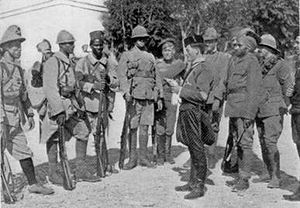Salonika Front
| Macedonian Front | |||||||
|---|---|---|---|---|---|---|---|
| Part of the Balkans Theatre (World War I) | |||||||
 From left to right: a soldier from Indochina, a Frenchman, a Senegalese, an Englishman, a Russian, an Italian, a Serb, a Greek, and an Indian. |
|||||||
|
|||||||
| Belligerents | |||||||
|
Central Powers: |
Allied Powers: |
||||||
| Commanders and leaders | |||||||
|
|
|
||||||
| Units involved | |||||||
|
Army Group Scholtz 11th German Army 1st Bulgarian Army 2nd Bulgarian Army 61st German Corps 2nd Bulgarian Division 3rd Bulgarian Division 302nd German Division 9th Bulgarian Division |
Allied Army of the Orient Armée d'Orient 1st Serbian Army 2nd Serbian Army British Salonika Army Army of National Defence 35th Italian Division |
||||||
| Strength | |||||||
|
1918 1,217 artillery pieces 2,710 machine guns 30 aeroplanes (Dec.1916 – May 1917), afterwards 4,300 (until May 1918). |
1918 717,000 men2,609 artillery pieces 2,682 machine guns 6,434 automatic rifles 200 aeroplanes |
||||||
| Casualties and losses | |||||||
|
|
|
||||||
1918
1918
The Macedonian Front of World War I, also known as the Salonica Front (after Thessaloniki), was formed as a result of an attempt by the Allied Powers to aid Serbia, in fall 1915, against the combined attack of Germany, Austria-Hungary and Bulgaria. The expedition came too late and in insufficient force to prevent the fall of Serbia, and was complicated by the internal political crisis in Greece (the "National Schism"). Eventually, a stable front was established, running from the Albanian Adriatic coast to the Struma River, pitting a multinational Allied force against the Bulgarian Army, which was at various times bolstered with smaller units from the other Central Powers. The Macedonian Front remained quite stable, despite local actions, until the great Allied offensive in September 1918, which resulted in the capitulation of Bulgaria and the liberation of Serbia.
Following the asassination of the Crown Prince by a Bosnian Serb, Austria-Hungary had attacked Serbia in August 1914 but had failed to overcome Serbian resistance. After the entry of the Ottoman Empire into the war on the side of the Central Powers (November 1914), the decisive factor in the Balkans became the attitude of Bulgaria. Bulgaria occupied a strategically important position on the Serbian flank and its intervention on either side of the belligerents would be decisive. Bulgaria and Serbia had fought each other twice in the previous thirty years: in the Serbo-Bulgarian War of 1885 and in the Second Balkan War of 1913. Bulgaria had suffered defeat in 1913 and the Bulgarian government and people generally felt that Serbia had stolen land which rightfully belonged to Bulgaria. While the Allies could only offer Bulgaria small territorial concessions from Serbia and neutral Greece, the Central Powers' promises appeared far more enticing, as they offered to cede most of the land which Bulgaria claimed. With the Allied defeats at the Battle of Gallipoli (April 1915 to January 1916) and the Russian defeat at Gorlice-Tarnów (May to September 1915) demonstrating the Central Powers' strength, King Ferdinand signed a treaty with Germany and on 21 September 1915 Bulgaria began mobilizing for war.
...
Wikipedia
